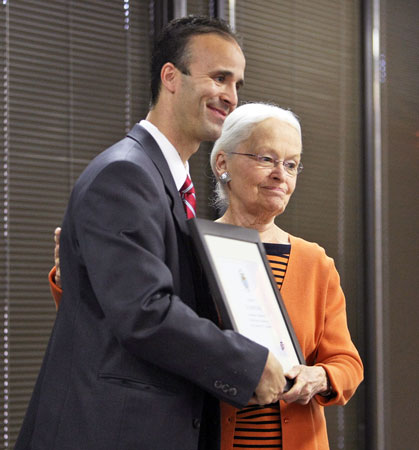Originally published May 9, 2016
By Laura L. Acosta
UTEP Communications
In 2005, Sandor Dorgo, Ph.D., emailed the chair of UTEP’s Department of Kinesiology about his idea to start a physical fitness program that would improve the overall health and increase the social interaction of adults 60 years and older.
His plan was to recruit kinesiology students to work with older adults and monitor their progress.

“This would be an excellent opportunity for our students to be involved in community service and see the relationship between a class-based project and the real life applications,” Dorgo wrote in his email to Harry Meeuwsen, Ph.D., in August 2005. “Everybody wins.”
The following day, Meeuwsen told Dorgo, an associate professor of kinesiology, to go for it.
With a $50,000 grant he received in December 2005 from the Paso del Norte Health Foundation’s Ageless Health Initiative, Dorgo launched the Physical Fitness in the Golden Age program at The University of Texas at El Paso in February 2006.
The program has enabled older adults in the Paso del Norte region to age gracefully by staying physically active.
In the 10 years since it started, more than 700 seniors and 1,500 students have participated.
“I stick with it because it’s wonderful,” said Corene Payan, who was one of the program’s first participants in 2006. As a member of the Blue Chicks with Sticks softball team, Payan said the program helps her stay fit for softball season. “It keeps us healthy. It keeps us active, and I have a lot of friends now.”
Payan and her friends celebrated the 10-year anniversary of the Physical Fitness in the Golden Age program at a dinner hosted by the College of Health Sciences in April 2016.
Nearly 200 guests, including UTEP President Diana Natalicio; Howard Daudistel, Ph.D., interim provost and vice president for academic affairs; Enrique Mata, senior program officer at the Paso del Norte Health Foundation; and David Lopez, recreation sports coordinator at the City of El Paso, joined Dorgo in recognizing the contributions from the program’s participants, UTEP and community organizations that have made the program successful.
Mata remarked that the Physical Fitness in the Golden Age program has changed the paradigm of aging in the region by connecting older adults with kinesiology students in a customized fitness program.
“You have generations of individuals who are starting their career paths and moving on and understanding with greater depth that we can age successfully,” Mata said.
President Natalicio presented Dorgo with a certificate of appreciation for his tireless efforts on behalf of the program, which has grown from 30 participants the first year to 300 participants in 2016.
“When we started this program, not even in our wildest dreams did we envision that we were going to be here 10 years later,” Dorgo said during his remarks. “Initially we planned for one year and then we planned for a second year, and then it just kept getting bigger.”
As part of the program, older adults who are healthy enough to exercise participate in weekly training sessions in the Ross Moore Fitness Research Facility on campus or at the Gary Del Palacio Recreation Center on the East side. A third location is expected to open in the fall of 2016.
Both sites offer a comfortable environment where seniors can work on their strength, health, agility and independence. Exercises are done under the supervision of certified kinesiology graduates, and undergraduates doing their fieldwork.
“I feel guilty if I don’t show up,” said Garry Barnard, 75, who exercises at the Ross Moore facility three times a week. “It’s like having private training. They teach you all the different techniques. It keeps me young.”
Approximately 60 to 70 undergraduate kinesiology students participate in the program each semester. Supervisors typically hold a bachelor’s degree and a relevant certification from a leading professional organization.
Michael Garcia is one of 30 supervisors who were recognized during the celebration. Garcia said his experience as a supervisor from 2008-09 helped him land a job as the recreation facility manager for the City of Las Cruces.
Participants who attended the most training sessions during the past 10 years also were recognized.
Ray Olivas was the grand champion, having racked up 1,121 training sessions since he joined the program in 2006.
“I didn’t know it was that much,” Olivas said with a laugh. The 76-year-old starts his workout at 6 a.m. on Mondays, Wednesdays and Fridays. “I just take it from day to day. I’m just trying to stay healthy and happy.”
As an extension of the program, members started the Golden Age Fitness Association to promote fitness and fun. Each year they help coordinate the Miner Dash 5K run/3K walk.
In 2015, the program inaugurated the Golden Age Games. Participants compete in individual or team track and field events.
Physical Fitness in the Golden Age is open to seniors age 60 and older with a doctor’s note. The cost is $99 per semester. For more information about the program, visit goldenagefitness.utep.edu.